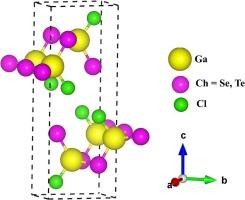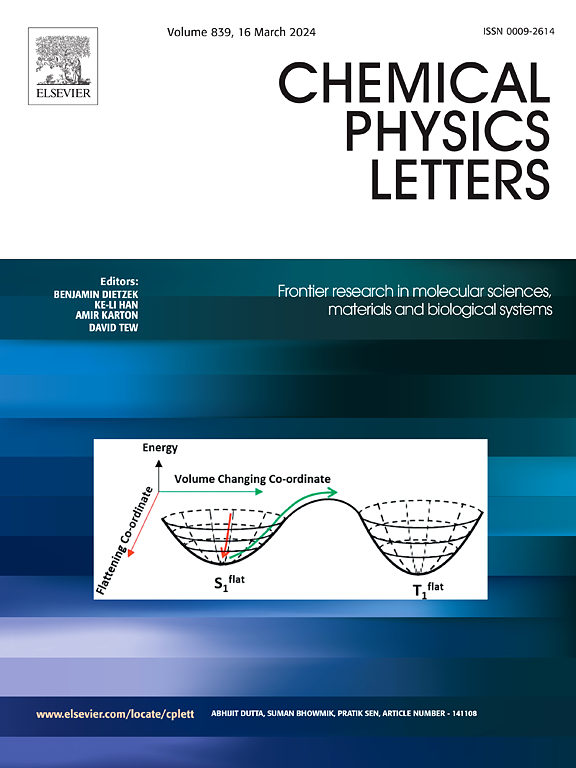Electronic structure and multifunctional properties of novel GaChCl (Ch = Se, Te) ternary chalcohalides: Insights from first-principles calculations
IF 3.1
3区 化学
Q3 CHEMISTRY, PHYSICAL
引用次数: 0
Abstract
A thorough first-principles investigation of the structural, electronic, mechanical, optical, and thermoelectric nature of orthorhombic GaChCl (Ch = Se, Te) ternary chalcohalides is carried out in the present work. Employing GGA-PBE and TB-mBJ functionals, both materials are identified as direct band gap semiconductors, with GaSeCl and GaTeCl possessing energy gaps of 3.79 eV and 2.97 eV, respectively. Optical investigations indicate strong interband transitions with significant absorption in the ultraviolet-visible region, as well as high refractive index and moderate reflection, showing that they are suitable for optoelectronic applications. Elastic property calculations demonstrate mechanical stability for both materials, with GaSeCl exhibiting stronger shear resistance compared to GaTeCl, which has improved ductility and elastic anisotropy. Thermoelectric investigations show a temperature-dependent Seebeck coefficient, electrical conductivity, and figure of merit (ZT), with GaSeCl attaining a peak ZT of 0.7 and GaTeCl reaching 0.6 at 450 K. The results presented indicate that the materials show an advantageous combination of thermal and electrical transport properties, particularly at high temperatures. The effect of chalcogen substitutions on electronic structure and transport phenomena highlights these compounds' versatility for multifunctional applications. The results have important implications regarding the design of next-generation energy conversion materials that feature efficient thermoelectric performance, mechanical durability, and robust optical responses.

新型GaChCl (Ch = Se, Te)三元乙醇化物的电子结构和多功能性质:第一性原理计算的见解
本文对正交GaChCl (Ch = Se, Te)三元甲醇化物的结构、电子、机械、光学和热电性质进行了深入的第一性原理研究。采用GGA-PBE和TB-mBJ功能,这两种材料都被确定为直接带隙半导体,其中GaSeCl和GaTeCl的能隙分别为3.79 eV和2.97 eV。光学研究表明,该材料具有较强的带间跃迁,在紫外可见区具有显著的吸收,以及高折射率和中等反射,适合光电应用。弹性性能计算证明了这两种材料的机械稳定性,与GaTeCl相比,GaSeCl具有更强的抗剪切能力,具有更好的延性和弹性各向异性。热电研究表明,温度依赖于塞贝克系数、电导率和品质系数(ZT),在450 K时,GaSeCl的峰值ZT为0.7,GaTeCl的峰值ZT为0.6。结果表明,该材料表现出良好的热输运和电输运组合性能,特别是在高温下。硫取代对电子结构和输运现象的影响突出了这些化合物在多功能应用中的多功能性。该研究结果对下一代能量转换材料的设计具有重要意义,这些材料具有高效的热电性能、机械耐久性和强大的光学响应。
本文章由计算机程序翻译,如有差异,请以英文原文为准。
求助全文
约1分钟内获得全文
求助全文
来源期刊

Chemical Physics Letters
化学-物理:原子、分子和化学物理
CiteScore
5.70
自引率
3.60%
发文量
798
审稿时长
33 days
期刊介绍:
Chemical Physics Letters has an open access mirror journal, Chemical Physics Letters: X, sharing the same aims and scope, editorial team, submission system and rigorous peer review.
Chemical Physics Letters publishes brief reports on molecules, interfaces, condensed phases, nanomaterials and nanostructures, polymers, biomolecular systems, and energy conversion and storage.
Criteria for publication are quality, urgency and impact. Further, experimental results reported in the journal have direct relevance for theory, and theoretical developments or non-routine computations relate directly to experiment. Manuscripts must satisfy these criteria and should not be minor extensions of previous work.
 求助内容:
求助内容: 应助结果提醒方式:
应助结果提醒方式:


